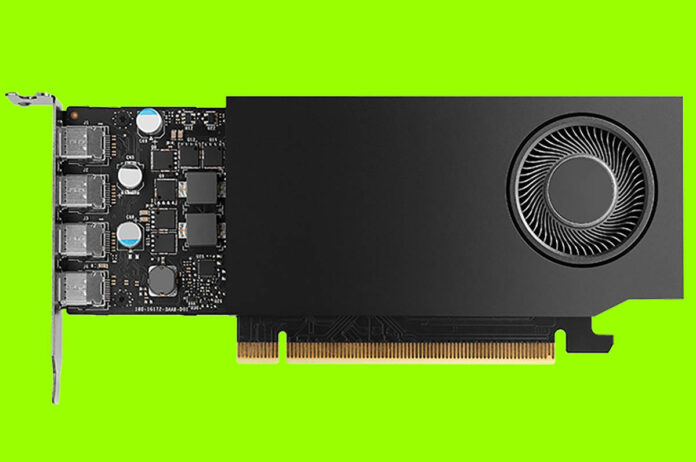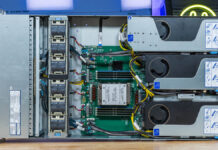NVIDIA launched two new GPUs today. The NVIDIA RTX A400 is the lowest-end model we have seen to date and the NVIDIA RTX A1000 ups the ante a bit. There are many similar features, but these are very distinct cards. The best part might be that these are low profile 50W cards so they should fit in most systems.
NVIDIA RTX A400 and RTX A1000 Lower-Cost Single-Slot GPUs
The NVIDIA RTX A400 is the lower-end card. It has 768 CUDA cores, 24 Tensor cores, 6 RT cores, and only 4GB of GDDR6 memory. With only a 64-bit memory interface, that leaves around 96GB/s of theoretical memory bandwidth.

The NVIDIA RTX A1000 is the higher-end card. It has 2307 CUDA cores, 72 Tensor cores, 18 RT cores, and 8GB of GDDR6 memory. The memory interface expands to 128-bit for around 192GB/s of theoretical memory bandwidth.
Both cards have four mDP 1.4a and 1x NVENC/ 2x NVDEC support with an AV1 decode as well. We also saw both cards as being 200mm2 dies with 8.7B transistors.
Final Words
NVIDIA says that the additional compute resources give the NVIDIA RTX A1000 more than twice the FLOPS of the RTX A400. Our sense is that if we had to pick between the two of these for a low-power single-slot PCIe Gen4 x8 system with only a 50W TDP power budget, we would pick the NVIDIA RTX A1000. Another worthwhile point is that this is the part of the market where integrated graphics have been charging. As AMD and Intel put more emphasis on integrated GPUs and NPUs in their products, cards like the NVIDIA A400 are going to offer, at best, a marginal gain for a lot of folks. On the other hand, sometimes you just need an NVIDIA GPU for software support purposes, and that is a big reason why these GPUs are deployed over integrated graphics.





These are a pretty bad choice all around as they’re based on Ampere architecture, meaning they’re missing several features compared to latest generation GPUs such as AV1 encoding, only supports up to CUDA 8.6 and is probably going to be more expensive than a much more powerful consumer version despite not having any advantages. The RTX 4060 will run circles around this card, and even comes in low profile versions.
AMD’s integrated graphics aren’t even supported by their GPU compute runtime ROCm – from consumer parts only the Radeon RX 7900 models are officially supported.
While almost all, if not all, NVIDIA GPUs are officially supported by CUDA.
Intel’s oneAPI also supports modern Xe iGPUs.
@David
While RTX 4060 is superior it requires external power, so it’s not really comparable to A400/A1000 in the first place.
Any idea how these compare to the Quadro K400? I’m using that as a plex transcoding gpu in my nas and it works great, but the K400 is pretty old now, if this is much faster might be a good upgrade.
I’ve just purchased an a400. I’m blown away what this thing can do. The a1000 mush be amazing…. It’s in a dell compact 3260, I almost got the drimmel out so I could get an a2000 in there but this is good enough.
It’s a huge upgrade over the k series like going from 6th gen to 13th gen. Get the oem version for £150 you won’t regret it.
I have been using Quadro P620 for quite sometime now and it served me really well. The P620 can handle 4K monitors and I can easily watch 4K videos. However, it struggles quite a bit with 8K videos. I even used this card with simpler video editor like “Shotcut” and edited well over 500+ videos. So, no complain here.
Looking at the specs, the A1000 model seems quite interesting to me. The power consumption is only 50W and with 8GB VRAM, this could be a great GPU for average users like me who wants multi-monitor support before anything else. Should be able to play 8K videos without any issue and minor video editing shouldn’t a problem either. I am pretty confident that A1000 should be able to do pretty much everything I want from my GPU. However, I would be interested to know what’s the idle temp of this GPU and the noise level of the cooling fan, specially when the card is under load.
Meanwhile, I used Intel Arc Pro A40 in the past and it seems like it’s not a quite GPU and runs fairly hot. Even with resizable bar on and all the tweaking articles of Intel, I couldn’t get the idle temp to go below 62 on my system. The cooling fan makes quite bit of noise when under load and it seems like fan ramps up at time even when it’s on idle mode. A bit weird indeed. I had to return the GPU.